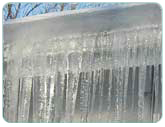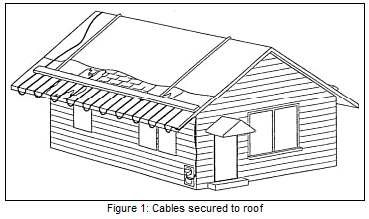Commonly asked questions about ice melters
The TRUTH about LEED Certified Ice Melt
Icemelters: What you should know

Snow covered roofs and sparkling icicles are beautiful on Christmas cards, but if it is your roof that’s sagging under the weight of ice build-up, or if you have melt-water dripping down your interior walls, the scene rapidly loses its appeal. But how do you deal with ice on your roof? It’s not as if it’s a sidewalk which you can easily apply icemelter to, and safely shovel off.
The most common problem for home owners when it comes to ice build-up on a sloped roof is known as the ice dam phenomenon. The portion of your roof that is over your living area is likely to be warmer than the edges of your roof – the overhang – which is typically the same temperature as the ambient winter air. Heat from your living area melts ice and snow and the resulting water runs down the slope toward the gutters; once the liquid water reaches the colder overhang, it freezes there and creates a barrier which now blocks water from escaping the roof altogether. Water then builds up at this juncture, pooling behind the ice dam, and this pooled water begins to find its way into your house.
Shingles, roof tiles, shakes, and flashing are all designed to shed water. They do not keep a pool of water from working its way underneath and then running down your walls or dripping through your light fixtures.
The most effective way to prevent this problem is to ensure there is a good quality vapour barrier between your ceiling and attic and to insulate your ceiling well. The attic must also have good ventilation so that the underside of the roof is as close to the outside temperature as possible. These measures will also minimize condensation in the attic which can freeze and then drip down onto the insulation and potentially into your living area.
It is easy to see if your house needs this kind of attention – just wait for a heavy frost or snowfall, and then stand back and take a look. If the roof area over the heated portion of your house is clear of frost or snow and the perimeter is still white and icy, then it’s time to call your contractor to address the problem in your attic. Better insulation in your ceiling will lower heating costs as well so this is a preventative exercise that will benefit you two ways. Until your contractor shows up, however, you’re going to need to watch for the formation of an ice dam.
If an ice dam has already formed, you may be tempted to get up on the roof and chip away at it. This is not a good idea. In the first place, roofing materials are not designed to have you bashing away on them with an ice pick, axe, or hammer. The roofing material will be brittle from the cold and this kind of action will likely break and remove chunks of your roof along with the ice.
A second and more serious problem with this approach is safety. Trying to work on an ice covered sloped roof is no joke and can easily result in broken bones – or worse. Wearing cleats will also damage your roof, so they’re not advised. If you must go onto the roof, you will need a well secured safety harness – or better yet, hire an experienced contractor with all the right equipment to take care of the issue.
If you’re working from a ladder, you will need someone else there to ensure the ladder itself does not slip, and you’ll have to be careful not to allow chunks of ice to fall on your helper – or any other pedestrians happening by.
To deal with the ice dam, a common strategy is to take some old nylons and cut the legs off. Fill these with a granular icemelter and then lay the filled stockings perpendicular to the gutter so that they will melt a series of channels through the ice dam and drain away the melt-water.
Rock salt is corrosive, however, and may damage flashing or roofing materials. Calcium chloride is similarly problematic and should also be avoided. CMA (Calcium Magnesium Acetate) is a safer alternative and fertilizer based icemelters such as MOI (Mountain Organic Icemelter) or GNI (GroundWorks Natural Icemelter) are also better options as they are less corrosive than salt. Keep in mind that whatever you put on your roof will be dripping onto your shrubbery so large quantities are best avoided. If you’re worried that an icemelt might discolour your roof, try some on a small portion first, before applying a larger amount.
Another strategy for dealing with ice dams is to use electrical heating cables to make drainage paths on the roof. If you attach the cables to a long board, then use rope to raise the heating cables onto the roof from the far side, you can safely get the cables positioned along the site of the ice dam formation with minimal risk to yourself. See figure 1 below.
Source: CMHC

Some people have used hot water to create channels through the ice dam as well. This works best if you can access the roof easily from a dormer window or other safe place. Remember that the water you pour on will get cold and then freeze so watch how you apply it. Hot water may crack windows or skylights too due to the heat differential, so exercise caution with this technique.
Finally, to prevent damage, it is best if you do as little as possible. Chipping off ice will harm your roofing material, and all of the other strategies are not without risk either. Your own safety is obviously paramount so climbing slippery ladders in icy weather, and standing on icy sloped roofing is best avoided.